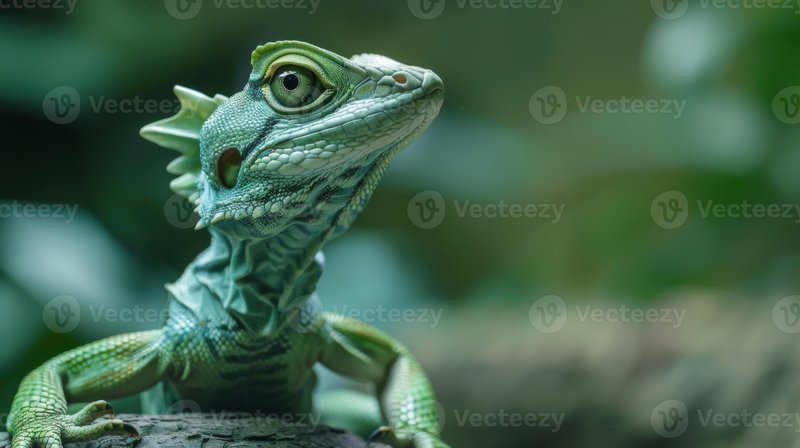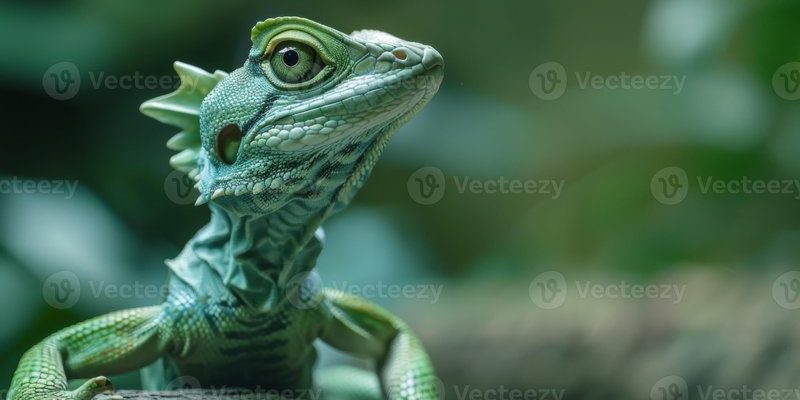
The Basilisk Lizard is one of nature’s most intriguing reptiles, often called the “Jesus Christ Lizard” for its incredible ability to run on water. Imagine a lizard dashing across the surface of a shimmering lake, almost as if it’s defying gravity itself! This fascinating creature captivates both scientists and casual observers alike with its vibrant colors and unique adaptations.
Originating from the humid tropical rainforests of Central and South America, the basilisk lizard isn’t just a pretty face. It’s armored with a series of distinctive features that enable it to thrive in its environment. With large frills on its neck and a long, muscular body, it thrives not only in trees but on the ground, where its hunting skills come to life. If you’ve ever been curious about how these lizards live, what they eat, and their extraordinary adaptations, you’re in the right place!
Physical Characteristics
When you first spot a basilisk lizard, you’ll likely be struck by its striking appearance. They can grow up to about 3 feet long, including their long tail, which can frequently be longer than their body. The most common species, the green basilisk, is adorned with bright green scales that provide excellent camouflage in the leafy environment of the rainforest.
One of the defining traits of the basilisk lizard is its crest, which runs from the back of its head down its back. This frill can vary in size and shape, giving each individual a unique appearance. Beyond their aesthetic charm, these crests play a role in communication and mating displays. If you think about it, they’re like nature’s very own fashion statements—but with a functional twist!
| Species Name: | Basiliscus basiliscus |
| Average Length: | 2-3 feet |
| Habitat: | Tropical rainforests |
| Diet: | Insects, fruits, and small animals |
| Speed: | Up to 15 mph |
| Lifespan: | Up to 7 years in captivity |
Habitat and Distribution
Basilisk lizards thrive in the lush, humid environments of Central and South America, particularly in areas rich with trees, rivers, and streams. They’re often found in the canopies of tropical rainforests where they can bask in the warm sunlight and hide from predators. Imagine the vibrant shades of green and rich sounds of wildlife that surround them! It’s a perfect habitat for these agile creatures.
These lizards are particularly fond of dense vegetation near water bodies—think streams where they can easily escape danger by running across the water’s surface. In fact, you might be surprised to learn that when basilisk lizards sprint away from threats, they use a unique movement that allows their feet to leave a light trail on the water. It’s as though they are performing a well-rehearsed dance, balancing on the water like they are gliding on air.
Diet and Feeding Habits
When it comes to meals, basilisk lizards are primarily insectivores, which means they enjoy munching on a variety of insects like crickets, grasshoppers, and beetles. However, they aren’t picky eaters! They also include fruits and smaller animals in their diet, giving them the necessary nutrients to stay healthy and energetic. Just picture them hunting in the underbrush, their keen eyes scanning for movement!
These lizards utilize their quick reflexes to catch prey, using their sharp vision to spot food from a distance. They often hunt during the day, which is when they are most active. You may find it fascinating that they can even eat fruits, which adds a splash of flavor to their otherwise insect-heavy diet. It’s a diet that suits their needs in the wild and allows them to thrive in their natural habitat.
Unique Adaptations
One of the most remarkable adaptations of the basilisk lizard is its ability to run on water. This skill is not just for show; it’s a critical survival tactic! By using their large feet and a special running technique, they can achieve speeds of up to 15 miles per hour. Imagine trying to run on water—you’d probably think it’s impossible, but these lizards have evolved perfectly for this challenge.
Additionally, basilisk lizards can also be seen climbing trees and staying well-hidden among the foliage. Their vibrant green color allows them to blend seamlessly into the leaves, providing excellent camouflage against predators. This coloration serves as a clever defense mechanism—one of the many ways they ensure their survival in a world full of dangers. It’s the ultimate game of hide and seek!
Reproduction and Lifecycle
During the breeding season, which typically occurs in the rainy months, male basilisk lizards can be quite the show-offs! They display their vibrant colors and perform fascinating courtship rituals to attract females. It’s almost like a dance as they show off their crests and engage in head-bobbing displays to win over a potential mate. Can you imagine the competition among the males? It must be quite a spectacle!
Once mating occurs, females will lay eggs in a clutch that can range from 4 to 20 eggs, depending on the species. The mother often buries the eggs in damp soil or leaf litter, camouflaging them from predators. After a short incubation period, hatchlings emerge, ready to take on the world. These young lizards are miniature versions of their parents and must quickly learn to fend for themselves in their forest homes.
Conservation Status
Despite their fascinating traits, basilisk lizards face threats due to habitat loss, primarily driven by deforestation and urban development. As these rainforest areas are cut down for agriculture or city expansion, the natural ecosystems that these lizards call home are being destroyed. It’s a concerning reality for a species that plays an essential role in maintaining the balance of its habitat.
Conservation efforts are crucial for protecting the basilisk lizard and ensuring that future generations can continue marveling at their extraordinary abilities. Preserving their habitat is vital, and organizations around the world are working tirelessly to advocate for sustainable practices that protect these amazing creatures and their environment. Every small effort counts, and together, we can help safeguard their future!
FAQ
What makes the basilisk lizard so unique?
The basilisk lizard is renowned for its remarkable ability to run on water. This unique adaptation allows it to escape predators in a quick and efficient manner. By utilizing its large feet, which are specially adapted to create enough surface area, the basilisk can sprint across the surface of water with ease. This incredible skill is not only fascinating to watch but plays a vital role in its survival.
How fast can basilisk lizards run?
Basilisk lizards can run at impressive speeds of up to 15 miles per hour. This speed is essential for escaping danger. They use their speed both on land and, more famously, on water, making them one of the fastest lizards in their habitats. Their quick reflexes and agility are key to their survival in the wild.
Where do basilisk lizards live?
These lizards are native to the tropical rainforests of Central and South America. They thrive in humid environments, usually found near water bodies like streams and rivers. Their preference for such habitats allows them to use their water-running ability effectively while also providing plenty of places to hide from predators.
What do basilisk lizards eat?
Basilisk lizards primarily feed on insects, such as crickets and beetles, but their diet can also include fruits and small animals. They are insectivores but are not restricted to eating only insects, which gives them a varied diet. Hunting during the daylight, they rely on their sharp vision to spot prey from a distance.
How do female basilisk lizards reproduce?
During the mating season, female basilisk lizards lay eggs in clutches ranging from 4 to 20. They typically bury their eggs in damp soil or leaf litter to protect them from predators. After a short incubation period, the hatchlings emerge and are independent from birth. This reproductive strategy ensures that at least some will survive the hazards of their environment.
Are basilisk lizards endangered?
While they are not currently listed as endangered, basilisk lizards do face threats from habitat destruction due to deforestation and urban development. Conservation efforts are important for protecting their habitats and ensuring that these unique creatures can continue to thrive in the wild. Awareness and action towards saving their habitats are crucial for their future.
Can basilisk lizards be kept as pets?
Basilisk lizards can be kept as pets, but they require specific care and environment to thrive. They need a spacious enclosure with adequate humidity, temperature control, and plenty of climbing opportunities. They are not the easiest reptiles to care for, so it’s important to research their needs thoroughly before considering one as a pet.
How long do basilisk lizards live?
In captivity, basilisk lizards can live up to 7 years, but their lifespan can vary based on care and environment. In the wild, their lifespan may be shorter due to predation and environmental factors. Proper nutrition, habitat conditions, and veterinary care can significantly impact a captive basilisk’s longevity.
What are the main predators of basilisk lizards?
Basilisk lizards face various predators, including birds of prey, snakes, and larger mammals. Their ability to run on water is a crucial defense mechanism that helps them escape from these threats. Being quick and agile allows them to evade capture, making them well-adapted to life in a world full of dangers.
Do basilisk lizards have any social behaviors?
Basilisk lizards are generally solitary creatures, though they may engage in social behaviors during mating season. Males often display to one another and to females through body movements and color displays. However, outside of breeding, they tend to be territorial and prefer to keep their distance from other lizards to avoid conflict.
Why are they called ‘Jesus Christ Lizard’?
The nickname ‘Jesus Christ Lizard’ comes from their incredible ability to run across water surfaces, reminiscent of the biblical story of Jesus walking on water. This nickname highlights not only their unique talent but also the wonder and amazement they inspire in those who witness this extraordinary behavior. It’s a fitting title for such a remarkable creature!

